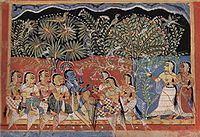- Works of Jayadeva
-
Jayadeva was a well known Sanskrit poet and lyricist who was born in Kenduli, Orissa in the 11th century AD. The works of Jayadeva have had a profound influence on Indian culture. It forms the basis of the east Indian classical dance form, Odissi, and has strongly influenced the Bharatanatyam classical dance as well as Carnatic music. Jayadeva's composition has also been incorporated in the Guru Granth Sahib.
Contents
Religion
Jayadeva has had a profound influence on the religious practices of Hinduism. The classic Tribhangi (threefold) posture of Krishna playing the flute gained popularity due to him.
Dashavatara
Jayadeva was instrumental in popularizing the Dasavatara, the ten incarnations of Krishna in his composition, Dasakritikrite. Additionally, the Gita Govinda begins with a Dasavatara stotra. In Jayadeva's version of Dasavatara, Buddha as an incarnation of Vishnu, while Krishna is not incorporated because Krishna is the source of all incarnations. as the lyrics says : keshava dhrta buddha sarira= krishna who appears in the form of Lord Buddha. since Keshava is another name of Krishna, that means Krishna is the source of / incarnate as BUddha
In July 2009, the government of India's Department of Posts has decided to release 11 stamps in Bhubaneswar to commemorate the birth of Jayadeva. One stamp depicts the poet himself, while the other ten depict the Dasavatara.[1] Chief Minister Naveen Patnaik unveiled the stamps at a special function in Jayadev Bhawan. The stamps are in the denomination of Rs 5. A total of 800,000 stamps were released for sale in Orissa.[2][3]
Hymns in the Guru Granth Sahib
Two hymns composed by Jayadeva have been incorporated in the Guru Granth Sahib, the holy book of the Sikh religion. Although it is not clear how these medieval Orissan hymns found their way to the Sikh religion, there are records narrating how Jayadeva's work had a profound influence on Guru Nanak during his visit to Puri.[4]
Music and dance
Odissi dance
In the opinion of researcher scholars, Jayadeva is among the centralmost figures in Oriya culture.[5][6] Jayadeva's ashtapadis that are sung in dance performances of Odissi, the classical dance of Orissa.[7]
Classical music of Orissa
Oriya bhajans (devotional songs) are based on ragas and talas specified by Jayadeva's hymns.[8] Jayadeva was a devotee of Krishna, and Krishna in the form of Jagannath is the central deity of Orissa.[9][10]
Fine arts
Jayadeva and his Gita Govinda had gained considerable popularity and had emerged as a painter’s theme by the late 15th century itself, though no such early paintings are available now. The earliest reported Gita Govinda paintings are from Mewar between 1590-1600 A.D.
Patachitra paintings
The Gita Govinda composed by Jayadeva is one of the popular themes in the traditional patachitra paintings of Orissa.[11][12][13]
Pahari paintings
Jayadeva had a profound influence on the Pahari school during the 17th-19th centuries, which was prevalent throughout northern India bordering the Hiimalayas (from Jammu through Himachal Pradesh). In paricular, Jayadeva's Radha and Krishna served as popular themes for Basohli Painting in Jammu and Kashmir.[14]
The Gita Govinda
Main article: Gita Govinda Gita Govinda manuscript c. 1500.
Gita Govinda manuscript c. 1500.
The Gita Govinda is the best known composition of Jayadeva. It is a lyrical poetry that is organized into twelve chapters. Each chapter is further sub-divided into twenty four divisions called Prabandhas. The prabandhas contain couplets grouped into eights, called Ashtapadis.
The first English translation of the Gita Govinda was published by Sir William Jones in 1792, where Kalinga (ancient Orissa) is referred to as the origin of the text. Since then, the Gita Govinda has been translated to many languages throughout the world, and is considered to be among the finest examples of Sanskrit poetry. Noteworthy among them is Love Song of the Dark Lord, by Barbara Stoler Miller.
Other literary contributions
Jayadeva wrote Piyusha Lahari, a Sanskrit Goshti Rupaka[15] It was based on the romantic love between Radha and Krishna similar in line to Gita Govindam. It was translated into Telugu language by Vavilala Somayajulu and published in 1993 by Telugu University in 1990.[16]
References
- ^ "Commemorative stamp on Jayadev released". The Hindu (Chennai, India). 28 July 2009. http://www.hindu.com/2009/07/28/stories/2009072852830300.htm.
- ^ "Orissa CM releases postal stamp on poet Jaydev". 2009. http://orissadiary.com/CurrentNews.asp?id=13639.
- ^ "Postal stamp on Jayadev". 2009. http://www.tathya.in/2009/story.asp?sno=3133.
- ^ Visit of Guru Nanak
- ^ "Jayadeva and Gitagovinda in the Traditions of Orissa". 1995. http://www.alibris.com/search/books/qwork/3417472/used/Jayadeva%20and%20Gitagovinda%20in%20the%20Traditions%20of%20Orissa.
- ^ "Influence of Gitagovinda on Orissa's Culture" (PDF). 2006. http://www.orissa.gov.in/e-magazine/Orissareview/Aug2006/engpdf/56-57.pdf.
- ^ "Dressing Lord Jagannatha in Silk: Cloth, Clothes, and Status" (PDF). 2004. http://www.krepublishers.com/02-Journals/JSS/JSS-08-0-000-000-2004-Web/JSS-08-2-085-178-2004-Abst-PDF/JSS-08-2-113-127-2004-Hacker/JSS-08-2-113-127-2004-Hacker.pdf.
- ^ "Sri Jayadev's Music and Its Impact on the Culture of Orissa" (PDF). 2004. http://www.orissa.gov.in/e-magazine/Orissareview/sept-oct2006/engpdf/37-40.pdf.
- ^ "The lord and his land" (PDF). 2006. http://www.orissa.gov.in/e-magazine/Orissareview/june2006/engpdf/158-163.pdf.
- ^ "The cult of Jagannath" (PDF). 2003. http://orissagov.nic.in/e-magazine/Orissareview/july2003/englishchpter/The%20Cult%20of%20Jagannath.pdf.
- ^ "Eminent literary luminaries of Orissa" (PDF). 2004. http://orissagov.nic.in/e-magazine/orissaannualreference/ORA-2004/pdf/eminent_literacy_luminaries_of_orissa.pdf.
- ^ "A Cult to Salvage Mankind" (PDF). 2006. http://www.orissa.gov.in/e-magazine/Orissareview/june2006/engpdf/or-june-06.pdf.
- ^ "Kamadeva's Pleasure Garden: Orissa". 1987. http://www.amazon.com/dp/8170183936/.
- ^ Pahari centres Arts of India: Architecture, Sculpture, Painting, Music, Dance and Handicraft, by Krishna Chaitanya. Published by Abhinav Publications, 1987. ISBN 8170172098. Page 62.
- ^ Piyusha Lahari published in Nagari Script in the Journal of The Kalinga Historical Research Society, vol 1, part 4
- ^ Piyusha Lahari, Telugu translation by Vavilala Somayajulu with Original Sanskrit script, Edited by Dr. V.V.L. Narasimha Rao, Telugu University publication series No. 104, Hyderabad, 1990.
See also
- Gita Govinda
- Jayadeva in Sikhism
Categories:
Wikimedia Foundation. 2010.
